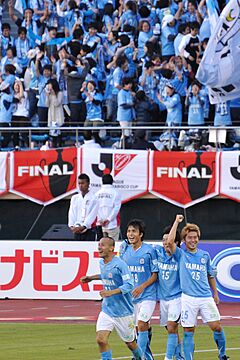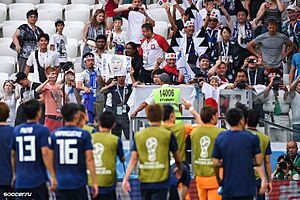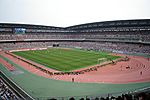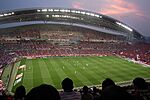Football in Japan facts for kids
Quick facts for kids Football in Japan |
|
|---|---|

Jubilo Iwata players and fans celebrate a goal in the J.League Cup in 2010.
|
|
| Country | Japan |
| Governing body | Japan Football Association |
| National team(s) | men's national team women's national team |
|
National competitions
|
|
|
Club competitions
|
|
|
|
|
International competitions
|
|
Football is one of the most popular sports in Japan. It's right up there with baseball, tennis, golf, sumo, and combat sports. The main group that runs football in Japan is called the Japan Football Association (JFA). They manage the professional leagues, like the J.League, which many people think is the best football league in Asia. Japan is also known for having very strong football programs for both men and women. They also do well in futsal (a type of indoor football) and beach soccer.
Contents
Football Terms in Japan
The official English name for the main football group is the Japan Football Association. But in Japan, people usually say sakkā (サッカー) instead of futtobōru (フットボール). Sakkā comes from the English word "soccer." The JFA's Japanese name is Nippon Sakkā Kyōkai.
Before World War II, people used the term shūkyū (蹴球), which means "kick-ball" in Japanese. After the war, American culture became more common in Japan. This led to "sakkā" being used more often. Today, many professional teams use "F.C." (Football Club) in their names, like FC Tokyo and Kyoto Sanga FC.
History of Football in Japan
Football was first brought to Japan in 1873. A British naval officer named Archibald Lucius Douglas and his team taught the game to Japanese navy students. This happened at the Imperial Japanese Navy Academy in Tokyo.
The first official football match in Japan happened on February 18, 1888. It was played between the Yokohama Country & Athletic Club and the Kobe Regatta & Athletic Club. The Yokohama club is the oldest football club still active in Japan. The first Japanese club formed just for football was Tokyo Shukyu-dan in 1917.
Early Football Growth
In the 1920s, football became more organized. Tournaments started in universities and high schools, especially in Tokyo. In 1930, the Japan national association football team was created. Their first big game was a 3–3 tie with China, which helped them win their first title at the Far Eastern Championship Games.
The Japanese national team also played in the 1936 Berlin Olympic Games. They had their first Olympic win there, beating a strong Sweden team 3–2.
National Competitions Develop
The Emperor's Cup was started in 1921. It was a national cup competition. Later, other national championships were tried. The All Japan Works Football Championship began in 1948 for company teams. The All Japan Inter-City Football Championship started in 1955 for city-based clubs. For a long time, university teams often won the Emperor's Cup. These early tournaments were like cup competitions, where teams were knocked out after one loss.
The Japan Soccer League
In 1965, the first organized national league, the Japan Soccer League (JSL), was formed. It started with eight amateur company clubs. At the 1968 Mexico Olympic Games, the Japan national team, made up of top JSL players, won a bronze medal. This success helped the JSL grow and even led to a second division.
At first, only foreign players, mostly from Brazil, could be professional. Japanese players were still amateurs and had to work regular jobs for the companies that owned their clubs. This slowed down the growth of Japanese football. Some good Japanese players, like Yasuhiko Okudera, had to go abroad to play professionally. He was the first Japanese player to play for a professional European club.
The J.League Era

In 1993, the Japan Professional Football League was created. This new league replaced the JSL and became the top professional league in Japan. The J.League clubs became fully professional and focused on their local communities. This new, higher-quality league brought in many more fans and made football much more popular. It also made it easier for amateur clubs to become professional, even without big company support.
Japan played in its first-ever FIFA World Cup in 1998 in France. In 2002, Japan and South Korea co-hosted the 2002 FIFA World Cup. Both countries' football groups received the FIFA Fair Play Award for this event. The Japanese national team has reached the Round of 16 in the World Cup four times: in 2002, 2010, 2018, and 2022.
Football in Stories and Cartoons
Football has also become popular through Japanese animation and comics. The first famous football-themed Japanese cartoon series, Captain Tsubasa, started in 1981. This series was super popular with kids in Japan. Its success led to many more football comics and cartoons. It even made playing football more popular than baseball in many schools in Japan during the 1980s.
Captain Tsubasa has inspired many famous footballers around the world to play the sport. Players like Hidetoshi Nakata, Zinedine Zidane, Francesco Totti, and Fernando Torres have said the series made them want to play football. The main character, Tsubasa Oozora, was partly inspired by Musashi Mizushima, who was one of the first Japanese footballers to play abroad.
Other popular Japanese cartoons about football include Giant Killing, Hungry Heart: Wild Striker, The Knight in the Area, Days, Inazuma Eleven, and Blue Lock.
Women's Football in Japan
Women's football in Japan is very well organized, similar to how it is in many European countries. Teams can move up or down between different leagues. The top league for women's football is the semi-professional L. League, also known as the Nadeshiko League. Most clubs are independent, but some J.League clubs now have women's teams too.
The Japan women's national football team has been very successful. They won the 2011 FIFA Women's World Cup in Germany, which was their biggest win ever! They also finished as runner-up in the 2015 tournament in Canada.
Small-Sided Football
Besides regular football, Japan also has popular small-sided versions of the game:
- Japan national futsal team
- F.League (Japan's professional futsal league)
- FIFA Futsal World Cup
- AFC Futsal Asian Cup
Championships and Tournaments
Japan hosts and participates in many exciting football tournaments.
Domestic Tournaments
These are competitions played within Japan:
- J.League: This is Japan's top professional league, with three divisions: J1, J2, and J3 League.
- Japan Football League (JFL): This is the top amateur league in Japan.
- Emperor's Cup: Started in 1921, this is a national cup open to many different types of teams.
- J.League Cup: This cup is usually only for teams in the J1 League.
- All Japan Adults Football Tournament: A cup for clubs in regional leagues below the JFL.
International Tournaments Hosted in Japan
Japan has hosted many big international football events:
- 1964 Tokyo Olympic Games
- 1979 FIFA World Youth Championship
- 1992 AFC Asian Cup in Hiroshima
- 2002 FIFA World Cup (co-hosted with South Korea)
- Intercontinental Cup / Toyota European/South American Cup (from 1981–2004)
- FIFA Club World Cup (several times between 2005 and 2016)
- 2020 Tokyo Olympic Games
Famous Japanese Footballers
Japan has produced many talented footballers who have made a big impact:
- Kunishige Kamamoto (born 1944): He was the top scorer at the 1968 Summer Olympics.
- Yasuhiko Okudera (born 1952): The first Japanese player to play in a European league (Germany's Bundesliga).
- Kazuyoshi Miura (born 1967): Known as "King Kazu," he was the Asian Footballer of the Year in 1993 and is currently the oldest professional footballer still playing!
- Hidetoshi Nakata (born 1977): A very famous player who was Asian Footballer of the Year in 1997 and 1998.
- Homare Sawa (born 1978): A legendary female player who won the FIFA Women's World Player of the Year in 2011. She is one of only two players (male or female) to play in six World Cup tournaments.
- Yasuhito Endō (born 1980): He has played the most games for the Japanese men's national team (152 matches).
Men's National Team Achievements
The Japanese men's national team, often called the "Samurai Blue," has achieved a lot:
- 1968 Mexico Olympic Games – Bronze Medal
- 1992 10th Asian Cup – Champions
- 2000 12th Asian Cup – Champions
- 2001 FIFA Confederations Cup – Silver Medal
- 2002 FIFA World Cup – Round of 16
- 2004 13th Asian Cup – Champions
- 2010 FIFA World Cup – Round of 16
- 2011 15th Asian Cup – Champions
- 2018 FIFA World Cup – Round of 16
- 2019 17th Asian Cup – Runners-up
- 2022 FIFA World Cup – Round of 16
Women's National Team Achievements
The Japanese women's national team, known as "Nadeshiko Japan," has also had great success:
- 1986 AFC Women's Championship – Runners-up
- 1990 Asian Games – Silver Medal
- 1991 AFC Women's Championship – Runners-up
- 1994 Asian Games – Silver Medal
- 1995 FIFA Women's World Cup – Quarter-finals
- 2006 Asian Games – Silver Medal
- 2010 Asian Games – Gold Medal
- 2011 FIFA Women's World Cup – Champions
- 2012 London Olympic Games – Silver Medal
- 2014 AFC Women's Asian Cup – Champions
- 2015 FIFA Women's World Cup – Runners-up
- 2018 AFC Women's Asian Cup – Champions
Football Stadiums in Japan
Japan has many impressive football stadiums. Here are some of the biggest:
| # | Image | Stadium | Capacity | City | Region | Built | Home team(s) |
|---|---|---|---|---|---|---|---|
| 1 |  |
Japan National Stadium | 80,016 | Tokyo | Kantō region | 2019 | Japan national football team (some matches) Japan national rugby union team |
| 2 |  |
Nissan Stadium | 72,327 | Yokohama | Kanagawa | 1998 | Yokohama F. Marinos |
| 3 |  |
Saitama Stadium 2002 | 63,700 | Saitama | Kantō region | 2001 | Japan national football team (most matches) Urawa Red Diamonds |
| 4 |  |
Shizuoka Stadium | 50,889 | Fukuroi | Shizuoka | 2001 | some Júbilo Iwata and Shimizu S-Pulse matches |
See also
- Sport in Japan
- Women's football in Japan
- Japan Football Association (JFA)
- Football competitions in Japan
- League System
- J.League
- League System
- Football competitions in Japan
* J1 League (Top Division) * J2 League (Second Division) * J3 League (Third Division)
-
-
-
- Japan Football League (Fourth Division)
- Japanese Regional Leagues (Fifth / Sixth Divisions)
- Cup Competitions
- Fujifilm Super Cup
- Emperor's Cup (National Open Cup)
- J.League YBC Levain Cup (League Cup)
-
-

